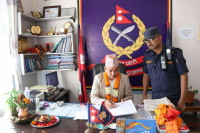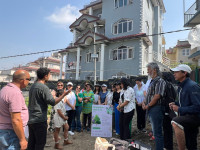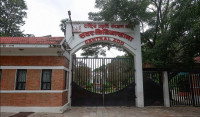Lalitpur
In Gabahal, the elderly stand in a queue for hours for their old-age allowances
There is little space to accommodate hundreds of elderly people who come to take their allowances in just five days, according to the Nepal Bank..jpg&w=900&height=601)
Anup Ojha
It’s drizzling outside and in front of the Nepal Bank in Gabahal, Lalitpur is a queue composed of a large number of elderly people waiting to collect their old-age allowance. Some are standing in the serpentine line with the support of a walking stick while others are sitting on the floor unable to stand for long. Everyone is holding onto their citizenship cards.
Ninety-year-old Prama Maya Shakya was tired, having stood in line for an hour.
“I won’t get the money if I don’t present myself,” said Shakya, a Gabahal native. “The authorities don’t give it to others.”
Local governments release old-age allowances for those above 65 years of age every four months through commercial banks. But depending on the area and the particular bank that has been mandated by the local government, the elderly often have to stand in line for hours to get their allowances.
“It would’ve been better if they had managed chairs for us to sit on. It’s difficult to stand for so long,” said 71-year-old Maiya Tamrakar.
Chaturbhuj Aryal, branch manager of the bank, however, said that there was little that the bank could do, given that they needed to provide allowances to thousands of elderly people in just five days, from September 29 to October 3.
“The allowance comes through Lalitpur Metropolitan City and we distribute it to them,” said Aryal. “I feel sad to see those elderly people standing in line to get their allowances but we are not able to control the big flow of people as we have very little space here.”
Nepal Bank alone distributes allowances to 9,000 people—6,000 elderly people and 3,000 pension holders—in the district, according to Aryal.
The government provides Rs3,000 a month, paid out in lump sums of Rs12,000 every four months. The allowance was increased from Rs2,000 to Rs3,000 in May. This allowance is paid out through banks selected by the local government.
According to Minister for Federal Affairs and General Administration Lal Babu Pandit, the government has made it mandatory to distribute elderly allowances through banks in all seven provinces.
“This was done to prevent irregularities as many local officials involved in distributing allowances were found embezzling the money,” Pandit told the Post.
According to the Senior Citizen Struggle Committee, an organisation of the elderly that advocates for the rights of the elderly, irregularities were rampant when the allowance was distributed through the wards. The children of the elderly would often take the allowance in their parents’ names and it would never reach them, they say. Corrupt public officials were also found to have embezzled millions in allowances.
According to Aryal of the Nepal Bank, the banking system is an improvement over the wards, but it comes with its own limitations.
“We don’t have any alternative means to serve them as most of them are illiterate and don’t know how to use ATM cards or get money through online payment systems,” said Aryal. “That’s why they have to come to the bank to collect the allowance.”
The situation, however, is not the same across the country. In parts of the Kathmandu Valley, private banks provide the old-age allowance and some even have a separate policy for the elderly.
According to Deepa Aryal, assistant customer service officer at Siddhartha Bank Hattisar, the bank takes special care of the elderly.
“Once the ward office deposits the money in our bank, we open separate counters for the elderly,” she said. “If they have to stay here for long, we manage separate chairs for them. We have a special provision for the elderly in all our branches.”
Lalitpur Mayor Chiri Babu Maharjan said that he had no idea this was happening in his city.
“We don’t have any intention to make the elderly suffer, as they have contributed so much to the nation,” Maharjan told the Post. “I will consult with stakeholders concerned and ward members to resolve this issue as soon as possible.”
It was former finance minister Bharat Mohan Adhikari who introduced the senior citizen allowance in 1994-95, starting with Rs100 for people above 75 years of age. The allowance remained the same for eight years.
In his second stint as finance minister, in 2004-05, Adhikari raised the allowance to Rs175. The allowance was later increased to Rs500 in 2008 during Baburam Bhattarai’s tenure and doubled to Rs1,000 by the Nepali Congress government in 2014 when Ram Sharan Mahat was finance minister.
Bishnu Paudel from the CPN-UML government doubled the amount to Rs2,000 in 2015. And this year, on May 29, Finance Minister Yubaraj Khatiwada increased the allowance to Rs3,000 while unveiling the budget for the fiscal year 2019-20.
During the 2017 elections, the then CPN-UML had announced that it would increase the allowance to Rs 5,000, but the party failed to deliver on its electoral promises though it now has a two-thirds majority in government.
“The government said that it will increase the elderly allowances to make our lives better,” said Maha Prasad Parajuli, president of the Senior Citizen Struggle Committee. “Instead, the government is making the elderly stand in a queue for hours.”
According to the 2011 census, there are around 2.1 million people aged over 60 or above in the country.




 10.12°C Kathmandu
10.12°C Kathmandu.jpg)










